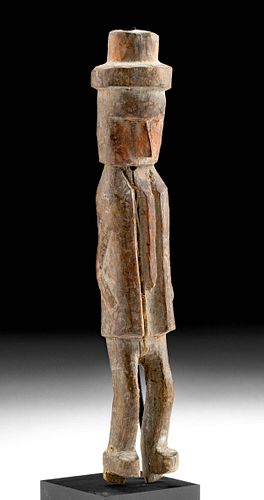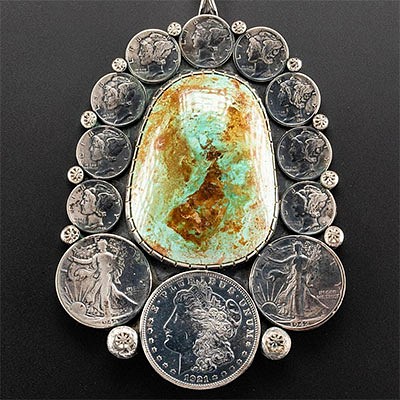Early 20th C. Panamanian Kuna Wood Figure w/ Top Hat
Lot 60a
About Seller
Artemis Gallery
686 S Taylor Ave, Ste 106
Louisville, CO 80027
United States
Selling antiquities, ancient and ethnographic art online since 1993, Artemis Gallery specializes in Classical Antiquities (Egyptian, Greek, Roman, Near Eastern), Asian, Pre-Columbian, African / Tribal / Oceanographic art. Our extensive inventory includes pottery, stone, metal, wood, glass and textil...Read more
Categories
Estimate:
$600 - $900
Absentee vs Live bid
Two ways to bid:
- Leave a max absentee bid and the platform will bid on your behalf up to your maximum bid during the live auction.
- Bid live during the auction and your bids will be submitted real-time to the auctioneer.
Bid Increments
| Price | Bid Increment |
|---|---|
| $0 | $25 |
| $300 | $50 |
| $1,000 | $100 |
| $2,000 | $250 |
| $5,000 | $500 |
| $10,000 | $1,000 |
| $20,000 | $2,500 |
| $50,000 | $5,000 |
| $100,000 | $10,000 |
| $200,000 | $20,000 |
About Auction
By Artemis Gallery
Feb 25, 2021
Set Reminder
2021-02-25 10:00:00
2021-02-25 10:00:00
America/New_York
Bidsquare
Bidsquare : American Frontier | Ethnographic | Tribal Art
https://www.bidsquare.com/auctions/artemis-gallery/american-frontier-ethnographic-tribal-art-6449
Featuring historical examples from the American, Spanish, and Mexican frontiers, as well as Native American, Ethnographic, Tribal, Oceanic, Spanish Colonial, more. All items offered for sale have been legally acquired, are legal to sell and are guaranteed to be as described or your money back. Artemis Gallery info@artemisgallery.com
Featuring historical examples from the American, Spanish, and Mexican frontiers, as well as Native American, Ethnographic, Tribal, Oceanic, Spanish Colonial, more. All items offered for sale have been legally acquired, are legal to sell and are guaranteed to be as described or your money back. Artemis Gallery info@artemisgallery.com
- Lot Description
Latin American, Panama, Kuna People, early 20th century CE. A wooden figure beautifully carved by the indigenous Kuna people of Panama and Colombia, known as a nuchu (uchu). As typical with nuchu, this figure stands upright with his arms along his torso. His minimalist face features a beak-like nose, a heavy brow, deep-set eyes, and no mouth. Painted a vivid hue of crimson, the figure wears a suit and tie as a top hat balances atop his square head. Size: 0.9" W x 5.625" H (2.3 cm x 14.3 cm); 6.25" H (15.9 cm) on included custom stand.
The Kuna people live on a series of thirty islands in the archipelago of San Blas in the Caribbean. This is a region of high humidity, hot temperatures, and intense rains. In their traditional medicinal practice, bad spirits of illness - known as "ponis" - must be expelled from the body by a traditional medicine man called an "inatuledi." The medicine man removes the illness using nuchu - good spirits - who are represented in wooden carvings. Nuchus are highly cherished by the Kuna people and, once the ill person has been healed, the nuchu is passed down from generation to generation.
This lovely nuchu was previously owned by Dr. Edward A. Spiegel (1931—2020), a professor of astronomy at New York University and Columbia University, who worked on convection theory and on the application of fluid dynamics to astrophysics. Aside from his foundation of the Chaos Theory, he gained a reputation among his students for his amusing stories of meeting other famous scientists such as Paul Dirac and Stephen Hawking.
A similar piece can be found at the Brooklyn Museum under accession number 70.154.1.
Provenance: private New York, New York, USA collection; ex-collection of Dr. Edward A. Spiegel
All items legal to buy/sell under U.S. Statute covering cultural patrimony Code 2600, CHAPTER 14, and are guaranteed to be as described or your money back.
A Certificate of Authenticity will accompany all winning bids.
We ship worldwide and handle all shipping in-house for your convenience.
#161306Stable fissure up front of body and neck, with light fading to pigment, otherwise intact and very good. Nice patina and remains of pigment. Drilled through posterior for display purposes.Condition
- Shipping Info
-
All shipping is handled in-house for your convenience. Your invoice from Artemis Gallery will include shipping calculation instructions. If in doubt, please inquire BEFORE bidding for estimated shipping costs for individual items.
-
- Buyer's Premium



 EUR
EUR CAD
CAD AUD
AUD GBP
GBP MXN
MXN HKD
HKD CNY
CNY MYR
MYR SEK
SEK SGD
SGD CHF
CHF THB
THB














